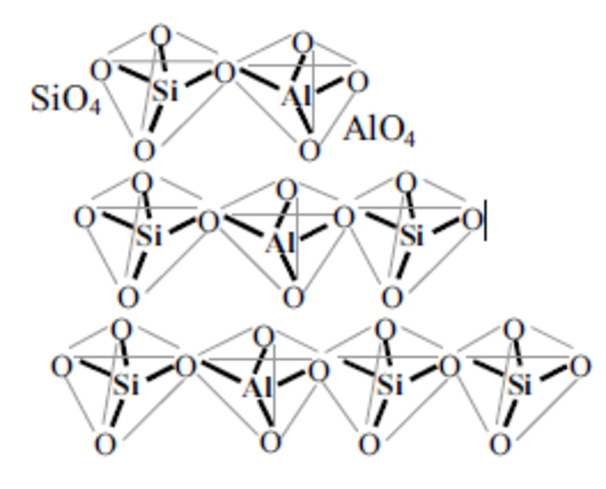
Rediscovered. For you.
Geopolymers serve as an alternative and supplement to concrete.
They consist of a three-dimensional network of silicate (SiO44-) and aluminate (AlO45-) anions, which are covalently bonded via oxygen atoms. These structures are formed when aluminosilicate such as metakaolin or slag is treated with strongly basic compounds such as alkali silicates (MR 1.6 - 3.0). When dissolving aluminosilicates in alkali silicates, polymerization of the aluminate with the silicate anions takes place, this leads to the formation of fully cross-linked, semi-crystalline solids, the geopolymers. Potassium silicate is usually used as the alkali source. Potassium silicate is more reactive than sodium silicate and, unlike the latter, does not lead to efflorescence.

The alternative to concrete
Fast and safe
Geopolymers are often used as a substitute for cementitious systems when rapid curing or rapid achievement of sufficient load-bearing capacity is required. In contrast to concrete, which normally takes several days to weeks to reach 90% of its final strength, geopolymers achieve this within a few hours.
Climate-friendly
Although both metakaolin and potassium silicates are produced via energy-intensive sintering and melting processes, the total CO2 emission can be reduced by at least 15% compared to cementitious systems. When replacing metakaolin with fly ash or slags, as well as via the silicate manufacturing process, CO2 emissions can be reduced to as much as 70% compared to cement.
Sustainable
Geopolymers are inorganic building materials based on locally available raw and waste materials.
Metakaolin is the thermally activated form of the mineral kaolinite; kaolinite itself occurs naturally almost everywhere on earth. The alternative raw materials slag and fly ash, although high-quality aluminate and silicate sources, are waste products that are also locally available.
At a glance
| Product | %K2O | %Na2O | %SiO2 | Weight ratio | Molar ratio |
|---|---|---|---|---|---|
| INOCOT 1001 B | - | 13.35 | 23.35 | 1.75 | 1.80 |
| INOCOT 1101 B | 29.40 | - | 18.70 | 0.64 | 1.00 |
| INOCOT 1102 B | 24.70 | - | 25.30 | 1.56 | 1.61 |

Versatile
Geopolymers are novel, environmentally friendly materials (low energy demand) that promise significant advances in the near future. But are they a new material, a new binder, or a new cement for concrete?
Geopolymers are all that and more.
They are new materials for coatings and adhesives, new binders for fiber composites, waste encapsulation, and new cement for concrete. In short, they are the mixture of metakaolin or fly ash with sodium or preferably potassium silicates, possibly with the addition of fillers.
Ultimately, they consist of a 3D framework of silicate (SiO44-) and aluminate (AlO45-) covalently bridged by common oxygen atoms.
Geopolymers exhibit exceptional physical properties: they are resistant to fire, heat, acid and corrosion and have high compressive strength.

The basic structure
| Raw material | Proportion |
|---|---|
| Silicate | 42.7 |
| Metakaolin | 25.5 |
| Filler (Cristobalite) | 31.6 |
Contact
![[Translate to English:] [Translate to English:]](/fileadmin/_processed_/1/3/csm_Caroline_Dorcier_d088e5eddc.jpg)
Caroline Dorcier
Head of R&D Laboratory

Service Center
Orders & Logistics